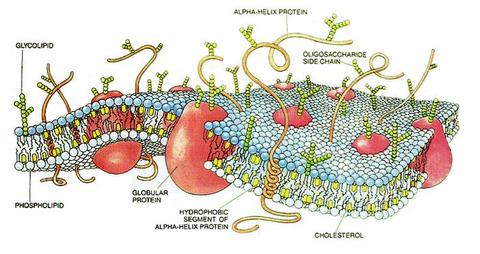Biology in Reflectometry

Essential Biological Functions
Immune response, Cell metabolism, Neurotransmission, Photosynthesis, Cell adherence, Cell growth and differentiation
Potential Commercial Applications
Drug response monitoring, Chemical manufacturing, Biosensing, Energy conversion, Tissue engineering
Introduction: membranes
All cells are enclosed by a biological membrane that defines its boundaries and regulates its interactions with the environment. The biological membrane consists of assemblies of lipid and protein molecules. The lipid molecules form a continuous double layer, or bilayer, which acts as a barrier to water-soluble molecules and provides the framework for the incorporation of the protein molecules. Specialized proteins embedded in lipid bilayers participate in fusion events between cells (i.e., triggered by viruses), regulate ion transport through pores and channels (i.e., neural activities), engage in enzymatic activity at membrane surfaces, and play a role in biological signaling (i.e., receptor proteins activated by hormones).
Cell membranes are sufficiently complicated that they cannot be duplicated in the laboratory for study. Thus, model biological, or biomimetic membranes, which are simpler than cell membranes but mimic their structure and function, are used to study these complicated systems. These systems can consist of lipid monolayers at the air/water interface or planar lipid bilayer systems supported on substrates at the solid/water interface. In both cases, the model systems must be capable of interacting with membrane peptides and proteins. The development of measurement tools for probing the structure and function of these engineered membrane mimics and the cell membrane components incorporated into them is essential for the optimization of their biomimetic character.
Contrast matching
An advantage in using neutron reflectivity for the study of biological systems is that neutrons are sensitive to the light elements, such as carbon, hydrogen, nitrogen and oxygen, which are so important in these materials. Furthermore, neutrons are sensitive to isotopic differences in these elements. Thus, a simple substitution of deuterium for hydrogen can substantially alter the SLD profiles of biological films, while having minimal effect on their biochemistry. By making several reflectivity measurements on the same system, but with different components deuterated, a more accurate model structure can be determined, since it must be consistent with all of the reflectivity data sets simultaneously. This 'contrast variation' method is used widely in the characterization of biomimetic films and its importance would be difficult to overstate.
During the past decade, neutron reflectivity has increasingly become an important technique for the characterization of biological and biomimetic thin films that are in contact with water. Advancements in instrumentation, sample environment and measurement protocols now make it possible to obtain Angstrom-level information about the composition of these materials along the axis perpendicular to the plane of the membrane. A newly-developed phase-sensitive neutron reflectivity technique now allows direct inversion of the reflectivity data to obtain unique compositional depth profiles of the films.
References
- Investigation of Hybrid Bilayer Membranes with Neutron Reflectometry: Probing the Interactions of Melittin
- Neutron reflection from interfaces with biological and biomimetic materials
- Neutron Reflectometry Characterization of Planar Soft-Supported Membrane-Mimetic Films
- Characterization of a Biomimetic Polymeric Lipid Bilayer by Phase Sensitive Neutron Reflectometry
Contacts
-
(301) 975-8839

